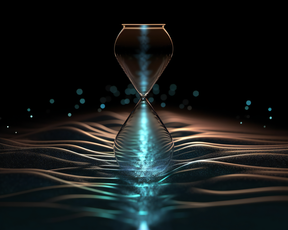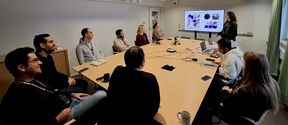A new type of photonic time crystal gives light a boost

Researchers have developed a way to create photonic time crystals and shown that these bizarre, artificial materials amplify the light that shines on them. These findings could lead to more efficient and robust wireless communications and significantly improved lasers.
Time crystals were first conceived by Nobel laureate Frank Wilczek in 2012. While conventional natural crystals have a structural pattern that repeats in space, in a time crystal, the pattern repeats in time instead. Although some physicists were initially skeptical that time crystals could exist, recent experiments have succeeded in creating them. Last year, researchers at Aalto University’s Low Temperature Laboratory created paired time crystals that could be useful for quantum devices.
Now, another team has made photonic time crystals, which are temporal analogues of conventional optical materials. The researchers created photonic time crystals that operate at microwave frequencies, and they showed that the crystals can amplify electromagnetic waves. This ability has potential applications in various technologies, including wireless communication, integrated circuits, and lasers.
So far, research on photonic time crystals has focused on bulk materials – that is, three-dimensional structures. This has proven enormously challenging, and the experiments haven’t gotten past model systems with no practical applications. Now, the team including researchers from Aalto University, the Karlsruhe Institute of Technology (KIT), and Stanford University tried a new approach: building a two-dimensional photonic time crystal.
‘We found that reducing the dimensionality from a 3D to a 2D structure made the implementation significantly easier, which made it possible to realise photonic time crystals in reality,’ says Xuchen Wang, the study’s lead author, who was a doctoral student at Aalto and is currently at KIT.
The new approach enabled the team to fabricate a photonic time crystal and experimentally verify the theoretical predictions about its behaviour. ‘We demonstrated for the first time that photonic time crystals can amplify incident light with high gain,’ says Wang.
‘In a photonic time crystal, the photons are arranged in a pattern that repeats over time. This means that the photons in the crystal are synchronized and coherent, which can lead to constructive interference and amplification of the light,’ explains Wang.
Two-dimensional photonic time crystals have a range of potential applications. By amplifying electromagnetic waves, they could make wireless transmitters and receivers more powerful or more efficient. Wang points out that coating surfaces with 2D photonic time crystals could also help with signal decay, which is a significant problem in wireless transmission. Photonic time crystals could also simplify laser designs by removing the need for bulk mirrors that are typically used in laser cavities.
Another application emerges from the finding that 2D photonic time crystals don’t just amplify electromagnetic waves that hit them from surrounding space but also waves travelling along surfaces. Surface waves are used for communication between electronic components in integrated circuits.
‘When a surface wave propagates, it suffers from material losses, and the signal strength is reduced. With 2D photonic time crystals integrated into the system, the surface wave can be amplified, and communication efficiency enhanced,’ says Professor Viktar Asadchy, who has generated the idea of 2D photonic time crystals.
The research is published by Science Advance on Wednesday 5th April 2023. Paper is found online https://doi.org/10.1126/sciadv.adg7541
More information:
Xuchen Wang
Postdoc at Karlsruher Institut für Technologie
xuchen.wang@kit.edu
Viktar Asadchy
Assistant Professor, Aalto University
viktar.asadchy@aalto.fi
tel +358 50 4205 846
Sergei Tretyakov
Professor, Aalto University
sergei.tretyakov@aalto.fi
tel +358 50 3502 562
Read more news
Apply to be a guest professor or visiting researcher at the Université Grenoble Alpes
Unite! partner, Université Grenoble Alpes (UGA) has opened a call to host international professors and researchers for short stays.
Floriane presents research findings on denim recycling
On 15 January 2026, Floriane Jacquin, an intern with the Textile Chemistry Group at Aalto University, presented the findings.
Postdoctoral researcher Eloi Moliner makes history as a 5-time award winner
Eloi Moliner is one of the most decorated doctoral researchers in Aalto University's history – we would like to highlight his success and contributions to the field of audio signal processing






